HISTORIC CHURCHES
King’s Memorial United Methodist Church
The oldest African American congregation in Decatur. The Reverend Richard “Dick”
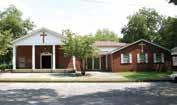
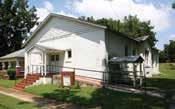
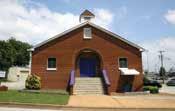
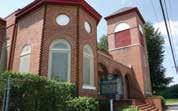
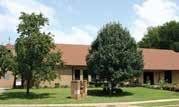
Rather, Pastor. In 1850, bi-racial and black members, of Decatur First Methodist Episcopal Church, South began meeting for afternoon worship. In 1854, the people of color, with their own money, built their sanctuary on Lafayette Street between Bank Street and Railroad Street.
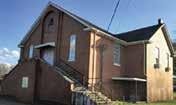
First Missionary Baptist Church
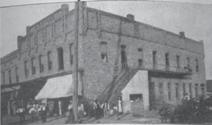
Founded in 1866, a year after emancipation.
The Reverend Alfred Peters, Pastor. The present church building was designed by prominent African American architect W.A. Rayfield in 1921 and constructed for $1,250.
The Rev. Elijah J. Lincoln organized church in 1878.
St. Stephen Primitive Baptist Church
Founded by Elder George Franklin, Pastor - 1875.
Wayman Chapel African Methodist Episcopal Church
The Reverend T.W. Coffee was assigned to Decatur Mission in 1877. The mission had six members.
Hidden in the pages of Decatur, Alabama’s history are the unmentioned and noteworthy African Americans, who made countless contributions to our city.

The River City was built on the backs of slaves and their descendants. The Old State Bank, which opened its doors July 29, 1833; is an example of their labor and craftsmanship. James Fennell, first Bank president, used slaves in the erection of the building. The slaves cut large stone pillars and hauled them from Trinity, Alabama to Decatur on ox drawn wagons. Many slaves worked on plantations, while others were hired out as blacksmiths, plasterers and laborers. The spirit and work of these pioneers continue to enrich and inspire past and future generations.
Civil War Soldiers

African Americans served both Union and Confederate Armies during the Civil War. The 106th United States Colored Infantry (USCI), organized in Decatur, is the first of only two black units raised in the State. Later the bravery of the 14th USCI was exhibited in Decatur, on October 28, 1864 when they saw combat with General John Bell Hood, resulting in a Union victory. The regiment first saw action on August 14-15, 1864, when it engaged in heavy skirmishing with raiding parties from General Joseph Wheeler’s cavalry at Dalton, Georgia. On August, 2009, a military grave marker was dedicated for 1st Alabama Cavalry, Union Civil War Soldier, Amos McKinney, who is buried at Magnolia-Sykes Cemetery in Decatur. Members of the 13th US Colored Troop and the 1st Alabama Cavalry reenactors (pictured at grave) took part in the ceremony. McKinney, who died Aug. 24, 1910 in Moulton, had been in an unmarked grave since his death. James J. Sykes purchased land for the Magnolia-Sykes Cemetery in 1901.
EARLY BUSINESSES OLD TOWN
Reconstruction to Early 1900s
• Robert Bridgeforth, Restaurant, 219 Bank Street; Livery Stable, 120 Market Street
• Robert Chardovoyne, Boot and Shoemaker
• J. W. Coleman, Grocer, Madison Street
• S. D. Elliott, Cleaning, Dyeing, 124 Lafayette Street

• A. G. Garth, Grocer, 602 Vine Street
• Lafayette Garth, Coal, 303 Bank Street
• Charles Grizzard, Grocer, 401 Wells Street
• Matilda Hall, Druggist and Notary Public
• Burrell W. Lemmons, Boarding House, Blacksmith and Grocer, Vine

• Sol Martin, Grocer, 426 W. Lafayette Street
• D. L. Miller, Barber, 602 Bank Street
• H. L. Murphy, Grocer, 505 Madison
• Madam Winnie Parker, Boarding House, Church Street
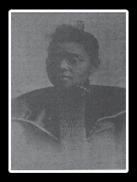
• Charles Ross, Barber, 307 Bank Street
• Samuel Schaudies, Boot and Shoemaker
• Willis E. Sterrs, M.D., Cottage Home Infirmary, Vine Street; Magnolia Drug Store and the People’s Dry Goods Store, Bank Street
• Solomon S. Sykes, Furniture, 225 Bank Street
• James J. Sykes, Grocer, Coal, Saloon, Tailor, Bank Street Constable John Mills - 1877
POLITICS OLD TOWN
Notary and Justice of the Peace Charles P. Sykes - 1892
Decatur City Council
• Burrell W. Lemons - elected 1880, former slave was sworn in as Decatur’s first black Alderman
• Matthew Hewlett Banks - elected 1884 Alderman and Mayor Pro Tem
• Charles P. Sykes - elected 1888
• Hershel V. Cashin - elected 1892
• James J. Sykes - elected 1894
• Russell Priest - July 1986, appointed to Decatur City Council
• Collis Stevenson - elected 1988
• William “Butch” Matthews - elected 1991
• William “Billy” Jackson – elected 1996 to present. Served as Decatur City Council President 2004-2008
Decatur City School Board
Collis Stevenson, Tommy Sykes, and Michelle Gray King
MEDICAL & DENTAL OLD TOWN
Early 1900s
Willis E. Sterrs, M.D., State Board 1888 – Decatur’s first African American Physician. Noted surgeon, founder of Cottage Home Infirmary and School of Nursing (Decatur’s first hospital)
J.W. Aldridge, M.D., State Board 1902
Newlyn E. Cashin, M.D., State Board 1908
Deo V. Darden, M.D., State Board 1914
L.P. Jacobs, D.D.S., 1905 City Directory
Willis J. Wood, D.D.S., 1920 Census
Winston H. Sherard, M.D.
JOURNALISM OLD TOWN
Mrs. Eva Adelaide Sterrs
Guardian Newspaper, Founder & Editor, 1910-1917
Eva Sterrs, Boys Club Benefactor
ATTORNEYS OLD TOWN
Shiloh Missionary Baptist Church
Printed in U.S.A./8-19
OLD TOWN FOR ADDITIONAL INFORMATION PLEASE VISIT MORGAN COUNTY ARCHIVES 624 Bank St NE, Decatur, AL 35601-1608; 256/351-4726 CONVENTIONS AND LARGE GROUPS WELCOME! DECATUR-MORGAN COUNTY TOURISM 719 6th Ave SE, Decatur, AL 35601 800/232-5449 or 256/350-2028 | www.DecaturCVB.org
H.
Decatur, Alabama.
Information researched by Peggy Allen Towns & Wylheme
Ragland,
Street
Photo courtesy NY digital library. Circa 1895.
Hershel V. Cashin, State Bar 1878 John A. Fountain, 1895
Garner Memorial Christian Methodist Episcopal Church
Formerly Bailey Temple Colored Methodist Episcopal Church, organized in the late 1800’s, with ten members. The name changed to Garner Memorial in 1945.
Freedmen’s School - Operated by the Methodist Freedmen’s Aid Society, from 1867 -1874. This information reveals that education for children of color began directly after the Civil War when the Northern Methodist officially returned to Alabama and Decatur.
First Private School - The first private school set up in the St. Stephen Primitive Baptist Church in 1875. After a fire, the school moved to St. Paul’s Methodist Episcopal Church {now known as King’s Memorial United Methodist Church}.
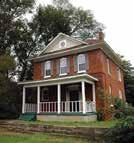
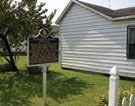
Decatur Negro High - June 2, 1935
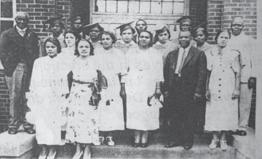
The Scottsboro Boys trials of the 1930’s, most of which took place in Decatur, Alabama, rank among the most significant cases in American legal history. Two precedent-setting United States Supreme Court cases came out of the trials. Worldwide media coverage laid bare the racial inequities of the American judicial system, especially within the racially segregated South.
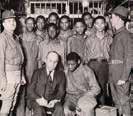
Photo taken at Decatur Negro High School.
Dr. George Washington Carver, renowned Tuskegee Institute scientist, Tuskegee, Alabama, delivered the Baccalaureate address to the graduating class at the Princess Theatre. An integrated audience of over 1,000 people attended. Clifford Joel Hurston (brother of writer Zora Neal Hurston) was principal at the High School. During Dr. Carver’s visit the East End School’s name changed to Carver Elementary, in his honor. The principal was William J. Wilson. Other African-American Schools were: Cherry Street School East End (later named Carver Westlawn Elementary School Elementary School) Lakeside High School
SCHAUDIES-BANKS COTTAGE
During the 1870s, Samuel Schaudies and Abbie Robinson Schaudies moved to this site from Huntsville and purchased this five-room cottage in 1881 for $800. The deed lists this site as part of Lot 84, “Old Town” Decatur. In 1875, their daughter, Tulie Ophelia, was born and, in 1898, she married H. J. Banks in the parlor. He was a descendant of a pioneer Decatur family, notary public, businessman, and son of a city alderman. Their daughter, Athelyne Celest, was born and lived in this cottage for 98 years. She was a tireless church worker, educator, and philanthropist. An academy, city park, and elementary school were named in her honor.
On March 25, 1931, nine young black men ranging from 13 to 19 were riding a freight train from Chattanooga to Memphis when a fight broke out between them and some young whites on the same train. The whites lost the fight and were forced from the train, they later filed a complaint with authorities who contacted the Jackson County Sheriff Department. A posse of armed men pulled the young black riders off the train at Paint Rock. They also discovered two young white women, Ruby Bates and Victoria Price leaving the train. The women said they had been raped, and as a result the nine men were taken into custody and brought to the jail at Scottsboro. Although a doctor’s exam of the accusers determined the story to be false, the District Attorney quickly brought charges against the nine defendants.
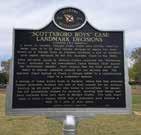
In a volatile atmosphere with the threat of violence, eight were quickly tried and sentenced to death. The jury could not reach a verdict for the ninth defendant, who was 13 years old. The NAACP raised money for the filing of appeals for the original verdicts, and these efforts were successful. The decision in Powell v. Alabama ruled that the defendants were entitled to adequate defense in a capital case.
The change of venue for the remaining trials was to Decatur, Alabama. Decatur was a city of about 16,000 at the time, whose population had recently been swelled by former farmers looking for work in the depths of the Great Depression. Decatur was not prepared for the drama and strife that would accompany the trials.
Tommy Lee Hines, a 25 year old black man with an IQ of 35 and the mental capacity of a six year old was arrested for loitering. Within minutes, he was accused of raping three white women and robbing one of them.
The Southern Christian Leadership Conference (SCLC), a Civil Rights organization sent representatives to Decatur, Alabama. Numerous rallies and demonstrations were held in support of Hines’ innocence. Tensions were high and racial turbulence exploded when the Ku Klux Klan clashed with protestors. A change of venue moved the case to Cullman County. Hines was found guilty by an all-white jury and sentenced to 30 years in prison. Later, an appeal in Jefferson County found him incompetent to stand trial. The impact of the case produced improvements in employment and better relations within the City.
The first trial in Decatur was that of Haywood Patterson, presided over by Circuit Judge James E. Horton. The case was prosecuted by Alabama Attorney General Thomas Knight, who sought publicity in the high-profile case. Patterson and the other defendants were defended by a team of attorneys led by prominent trial lawyer Samuel Leibowitz of New York. Controversially, the defense was funded by the International Labor Defense, an arm of the American Communist Party. Leibowitz attempted to quash the indictments by arguing that the defendants could not receive a fair trial by a jury of their peers because no blacks were allowed on juries. He called prominent qualified black men from Jackson and Morgan Counties to testify that they had never been summoned for jury duty. Although Horton did not allow the motion, the argument set the precedent for the later U.S. Supreme Court decision in Norris v. Alabama, which guaranteed the inclusion of blacks in jury rolls.
The Patterson trial gathered international media attention. Leibowitz mounted a masterful defense refuting the prosecution’s case, capped by the production of Ruby Bates, who refuted her previous testimony and denied any rape had occurred. The defense was not enough to convince the all-white jury, who convicted Patterson anyway. As worldwide outrage mounted, Judge Horton bravely set aside the verdict. Several more trials occurred, but the defendants all eventually went free, some had their cases dropped and some were paroled after serving time. None were executed.
Scottsboro Boys Tour
1. Morgan County Courthouse, 302 Lee Street NE
2. Dr. Frank J. Sykes, 812 Well Street NE
3. Judge William W. Callahan, 814 Ferry Street NE
4. Old State Bank and Black Business District
925 Bank Street NE
5. Historic Union Depot, 701 Railroad Street NW
6. Boarding House, 815 Sycamore Street NW
7. Galileo N. Sykes, 111 Church Street NW
8. Dr. Willis J. Wood, 129 Wilson Street NW
9. Hewlett J. Banks, 1004 Sycamore Street NW
10. First Missionary Baptist Church
233 Vine Street NW and Vine Street Commercial District
11. Decatur Morgan County Archives 624 Bank Street NE
Tommy Lee Hines Tour
A. Decatur City Hall 402 Lee Street NE
B. United States Post Office 400 Well Street NE
C. Morgan County Courthouse
302 Lee Street NE
D. Confrontation Blacks and Klan, 212 Lee Street NE
E. Morgan County Archives

F. First Missionary Baptist Church, 233 Vine Street NW
G. Hines Home site 504 Madison Street NW
H. Old Cherry Street School Site and Marker, Corner Davis Street and Davis Court NW
I. Newcomb Street Church of Christ, 726 Newcomb Street NW
J. Wayman Chapel AME Church, 412 Church Street NW
Norfolk Southern Railroad Newcomb St NW Davis St NE Cain St NE Cherry St NE Cherry St NE Walnut St NE Walnut St NE Walnut St NE Vine St NE Vine St NW Vine St NE Lafayette St NE Market St NE Wilson Church St Lafayette St WalnutSt Cherry CherryStNE NEAve4th HollyStNE MOULTON Ferry St NE BANK ST LeeStNE Ferry St NE Oak St NE Canal St NE Sycamore St. NE Grove St NW Washington St NW Railroad St NW Line St NE Well St NE SIXTHAVE TENNESSEE RIVER WHEELER LAKE 31 20 72 Alt Lafayette St NW Church St NW Church St NE Madison St NW McCartney St. NW Rhodes Ferry Park Cherry St NW Walnut St NW Walnut St NW DavisStNW 1 2 3 4 5 10 6 7 8 9 Scottsboro Boys Tour Tommy Lee Hines Tour 11 A B E D C F G H I J N EDUCATION OLD TOWN
OLD TOWN TOMMY LEE
OLD TOWN
SCOTTSBORO BOYS TRIAL
HINES TRial
OLD TOWN
Boarding House on Sycamore St. where Victoria Price or Ruby Bates lived.


















